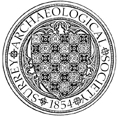Pound Lane, Godalming
Evaluation by B Matthews of OAU, for Care UK Community Partnership, of a redevelopment site on the edge of the town centre. A probable garden soil, containing 19th century pottery, sealed the natural. The only earlier evidence were two areas of disturbance in the natural, interpreted as tree root holes, one of which contained a sherd of probably 16th century Border Ware.


